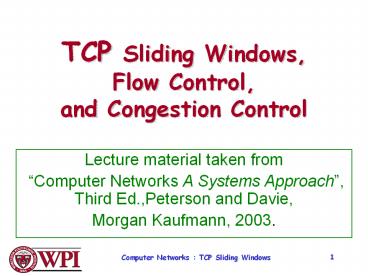TCP Sliding Windows, Flow Control, and Congestion Control - PowerPoint PPT Presentation
Title:
TCP Sliding Windows, Flow Control, and Congestion Control
Description:
TCP Sliding Windows, Flow Control, and Congestion Control Lecture material taken from Computer Networks A Systems Approach , Third Ed.,Peterson and Davie, – PowerPoint PPT presentation
Number of Views:138
Avg rating:3.0/5.0
Title: TCP Sliding Windows, Flow Control, and Congestion Control
1
TCP Sliding Windows,Flow Control,and Congestion
Control
- Lecture material taken from
- Computer Networks A Systems Approach, Third
Ed.,Peterson and Davie, - Morgan Kaufmann, 2003.
2
Sliding Windows
- Normally a data link layer concept.
- Our interest is understanding the TCP mechanism
at the transport layer. - Each frame is assigned a sequence number SeqNum.
- The sender maintains three variables send window
size (SWS), last ACK received (LAR), and last
Frame sent (LFS).
3
Sender Variables
- SWS the upper bound on the number of
outstanding frames (not ACKed) the sender can
transmit. - LAR the sequence number of the last ACK
received. - LFS the sequence number of the last frame sent.
4
Sender Invariant
- LFS LAR SWS
SWS
LAR
LFS
5
Sender Window
- An arriving ACK ? LAR moves right 1
- ? sender can send one more frame.
- Associate a timer with each frame the sender
transmits. - Sender retransmits the frame if the timer times
out. - Sender buffer up to SWS frames.
6
Receiver Variables
- Receiver window size (RWS) the upper bound on
the number of out-of-order frames the receiver is
willing to accept. - Largest acceptable frame (LAF) the sequence
number of the largest acceptable frame. - Last frame received (LFR) the sequence number
of the last frame received.
7
Receiver Invariant
- LAF LFR RWS
RWS
LFR
LAF
8
Receiver Window
- When a frame arrives with SeqNum
- If (SeqNum LFR or SeqNum gt LAF)
- the frame is discarded because it is outside
the window. - If (LFR lt SeqNum LAF)
- the frame is accepted.
9
Receiver ACK Decisions
- SeqNumToAck largest sequence number not yet
ACKed such that all frames SeqNumToAck have
been received. - Receiver ACKs receipt of SeqNumToAck
- and sets
- LFR SeqNumToAck
- LAF LFR RWS
- SeqNumToAck is adjusted appropriately!
10
Generic ACK Choices
- ACK sequence number indicates the last frame
successfully received. - - OR -
- 2. ACK sequence number indicates the next frame
the receiver expects to receive. - Both of these can be strictly individual ACKs or
represent cumulative ACKing. - Cumulative ACKing is the most common technique.
11
Generic Responses to a lost packet or frame
- Use a duplicate ACK.
- 2. Use a selective ACK SACK.
- 3. Use a negative ACK NACK .
12
TCP Sliding Windows
- In practice, the TCP implementation switches from
packet pointers to byte pointers. - Guarantees reliable delivery of data.
- Ensures data delivered in order.
- Enforces flow control between sender and
receiver. - The idea is the sender does not overrun the
receivers buffer.
13
Figure 5.3 TCP Managing a Byte Stream
14
Figure 5.8 Relationship between TCP Send Buffer
and TCP Receive Buffer
15
Receivers Advertised Window
- The big difference in TCP is that the size of the
sliding window size at the TCP receiver is not
fixed. - The receiver advertises an adjustable window size
(AdvertisedWindow field in TCP header). - Sender is limited to having no more than
AdvertisedWindow bytes of unACKed data at any
time.
16
TCP Flow Control
- The discussion is similar to the previous sliding
window mechanism except we add the complexity of
sending and receiving application processes that
are filling and emptying their local buffers. - Also we introduce the complexity that buffers are
of finite size without worrying about where the
buffers are stored. - MaxSendBuffer
- MaxRcvBuffer
17
TCP Flow Control
- Receiver throttles sender by advertising a window
size no larger than the amount it can buffer. - On TCP receiver side
- LastByteRcvd - LastByteRead MaxRcvBuffer
- to avoid buffer overflow!
18
TCP Flow Control
- TCP receiver advertises
- AdvertisedWindow MaxRcvBuffer -
- (LastByteRcvd - LastByteRead)
- i.e., the amount of free space available in the
receivers buffer.
19
TCP Flow Control
- The TCP sender must adhere to AdvertisedWindow
from the receiver such that - LastByteSent LastByteAcked AdvertisedWindow
- or use EffectiveWindow
- EffectiveWindow AdvertisedWindow
(LastByteSent LastByteAcked)
20
TCP Flow Control
- Sender Flow Control Rules
- EffectiveWindow gt 0 for sender to send more
data. - LastByteWritten LastByteAcked MaxSendBuffer
- equality here ? send buffer is full!!
- ? TCP sender process must block the sender
application.
21
TCP Congestion Control
- CongestionWindow a variable held by the TCP
source for each connection. - TCP is modified such that the maximum number of
bytes of unacknowledged data allowed is the
minimum of CongestionWindow and AdvertisedWindow. - MaxWindow min (CongestionWindow ,
AdvertisedWindow)
22
TCP Congestion Control
- Finally, we have that
- EffectiveWindow MaxWindow (LastByteSent
LastByteAcked) - The idea the sources effective window can be
no faster than the slowest of the network (i.e.,
its core routers) or the destination Host. - The TCP source receives implicit and/or explicit
indications of congestion by which to reduce
the size of CongestionWindow.































